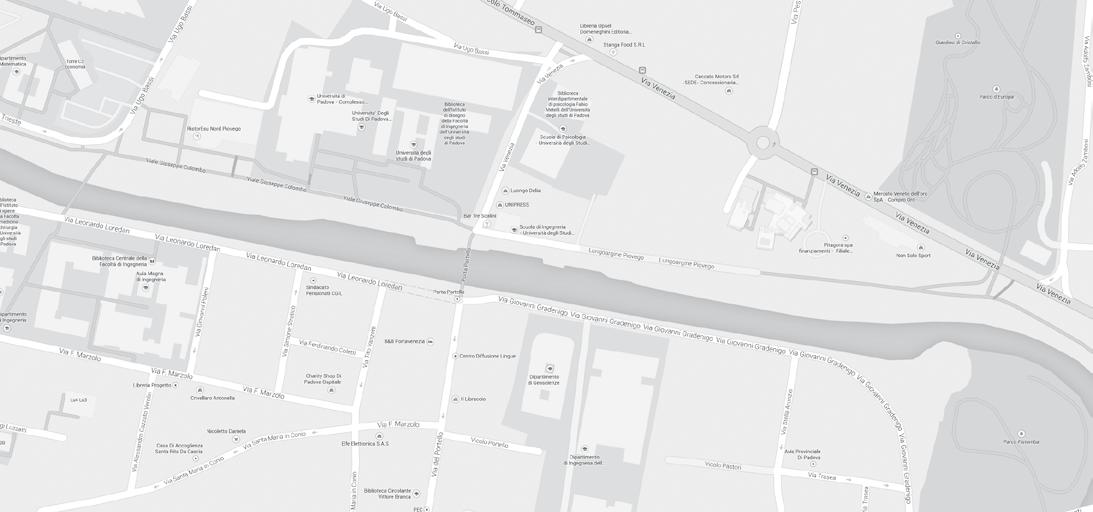DIINFORMA
DEL DIPARTIMENTO DI INGEGNERIA INDUSTRIALE DELL’UNIVERSITÀ DEGLI STUDI DI PADOVA

DICEMBRE 2022 03.8 Geometrical modelling of gyroid lattices for advanced porous materials Geometrical modelling of gyroid lattices for advanced porous materials
NEWSLETTER
Modellizzazione geometrica di giroidi per materiali porosi avanzati Geometrical modelling of gyroid lattices for advanced porous materials
Bioengineering, biotechnology and health technologies
Experimental and computational analysis of surgical meshes for abdominal hernia repair
Aerospace Engineering
Robotic capture of space debris with innovative GNC solutions conversion
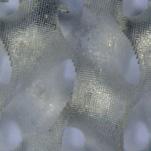
Industrial processes and products
Digitalization helps reduce energy consumption in the industrial manufacturing of specialty chemicals
Bioengineering,
biotechnology and health technologies
A design method for custom functionally graded lattice orthoses
Energy
H-HOPE: Hidden Hydro Oscillating Power for Europe
Materials
Inorganic polymers from an engineered mixture of waste: from binders to sorbents for dye removal
Environmental and industrial safety
Life cycle sustainability assessment to support ecoinnovation in HO-FOOD project
Aerospace Engineering
COPERTINA DII NFORMA
10 12 11
ERMES: Experimental Rendezvous in Microgravity Environment Study Speciale Progetto D3VeRo Cover Story 3 PAGINA 4 5 6 7 8 9
Experimental and computational analysis of surgical meshes for abdominal hernia repair
e treatment of abdominal wall hernia involves the use of synthetic surgical meshes to support the impaired muscles after defect closure. However, adverse effects as infections, pain and discomfort are still diffused among patients that underwent this surgical procedure. is research provides an integrated experimental and computational approach to support the selection of suitable prostheses for hernia repair according to patient-specific clinical conditions. Our research activity is based on the analysis of mesh polymeric materials and structural properties for a biomechanical compatibility evaluation. Mechanical properties are characterized following test protocols that mimic in vivo loading conditions. Synthetic meshes exhibit non-linear stress-strain properties and show varying anisotropy depending on their textile pattern. is behavior is described through constitutive models with specific parameters, for the implementation in numerical models. In silico trials are performed by means of FE models of the abdominal wall, simulating both the passive and active mechanical behavior of the tissues and different levels of intra-abdominal pressure. Hernia occurrence and surgical mesh repair are mimicked. Numerical analyses allow evaluating the biomechanical performance of hernia prosthesis and their interaction with biological tissues.
Bioingegneria, biotecnologia e tecnologie per la salute
Bioengineering, biotechn ology and health technologies
DII research group
Biomechanics Mechanics of biological materials

Silvia Todros
silvia.todros@unipd.it

Phone: +39 049 8276878
Piero Pavan piero.pavan@unipd.it Phone: +39 049 8276830
www.dii.unipd.it
The research activity has been carried out in collaboration with Dr. Nicola Baldan (Padova General Hospital) and Prof. Stefano Merigliano (Dept. of Oncologic and Gastroenterologic Surgical Science, University of Padova)

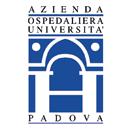
Figure 1. Biaxial tensile tests on a surgical mesh. Experimental set-up with markers for local strain measurement (a). Test directions for meshes 1 (b) and 2 (c). Results of equi-biaxial tensile tests, reported as force per unit width (F/w0) vs. nominal strain (e), in two test directions, for meshes 1 (d) and 2 (e).
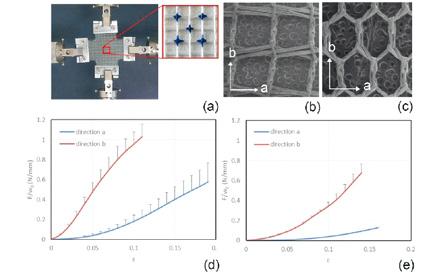

Main research topics:
• Mechanical characterization of biomedical polymers
• Mechanical behavior of tissues from human/animal models
• Development and characterization of scaffolds for tissue engineering
• Constitutive modelling of biomedical materials and tissues
• Computational biomechanics
3
DIINFORMA
Figure 2. Numerical modeling of abdominal hernia repair. Anatomical structures in FE model of half abdominal wall (a): Linea Alba (LA), Rectus Abdominis (RA), aponeurosis, External Oblique (EO), Internal Oblique (IO) and Transversus Abdominis (TA). Contour of magnitude displacement of healthy (b), herniated (c) and surgically repaired (d) abdomen at high intra-abdominal pressure.
Sistemi aerospaziali
Aerospace systems
Flight dynamics and space systems - FLIGHTDS
Francesco Branz francesco.branz@unipd.it Phone: +39 049 8276779



Robotic capture of space debris with innovative GNC solutions
When in orbit, a spacecraft is virtually inaccessible and, if a failure occurs or the satellite runs out of propellant, it is likely to became a space debris, i.e. an artificial orbital object that no longer serves an useful function. Space debris pose a threat of collision to other satellites, thus potentially limiting the accessibility to specific orbits. Promising solutions to this problem include the implementation of In-Orbit Servicing (IOS) and Active Debris Removal (ADR) missions. IOS refers to orbital operations conducted by a space vehicle that provides in situ services to a resident satellite, including inspection, orbit modification, refuelling, upgrade, repair, assembly. Differently, ADR missions focus on capturing large pieces of debris and deorbiting them. Both the mentioned mission concepts involve close-proximity operations between two satellites and the capture of a target object. Robotic systems supported by Guidance, Navigation and Control (GNC) algorithms are good candidates to implement IOS and ADR mission profiles.

Partners: European Space Agency (ESA)
Politecnico di Milano
Università degli Studi di Napoli «Federico II»
e study, funded by the European Space Agency, focuses on the development of enabling GNC technologies for proximity operations conducted by a chaser spacecraft equipped with a robotic arm. Navigation and control algorithms are designed in cooperation with the research partners and accurately tested within significant mission scenarios by means of a numerical simulation tool. e research project has the dual goal of: (1) developing combined-control GNC solutions to enable the capture of a target spacecraft by an autonomous chaser satellite equipped with a robotic arm; (2) developing a software tool that supports the design of GNC solutions by providing a reliable and realistic dynamic simulation. e developed GNC system is tailored to three application scenarios that consider target objects with different level of cooperativeness (capability to exchange information with chaser) and collaborativeness (capability to keep an attitude profile that facilitates the chaser operations). e development of a complete simulation environment (Functional Engineering Simulator, FES) is of key importance for the verification of the mentioned technologies. e FES features a reusable modular structure making it a valuable design tool for GNC related technologies in the framework of orbital proximity operations, even beyond the specific applications developed in this study. Simulation results prove the effectiveness of the developed GNC solutions and the accuracy of the simulation tool.
4 DIINFORMA
Main research topics: • Space debris: risk analysis, protection systems from hypervelocity impact, risk mitigation • Active Debris Removal • Miniaturized satellites: on board technologies and payloads • Systems for rendezvous and docking of satellites
https://www.dii.unipd.it/en/ ightds
DII research group
Federico Basana federico.basana@phd.unipd.it
Alessandro Francesconi alessandro.francesconi@unipd.it Phone: +39 049 8276811
Digitalization helps reduce energy consumption in the industrial manufacturing of specialty chemicals
Batch processes are widespread in many industries producing low volumes of high value-added goods, such as specialty chemicals, (bio) pharmaceuticals, and food. Whereas batch processing increases manufacturing flexibility, it can be more energy demanding than continuous processing. To give just a figure, the cost of energy for common chemicals produced by batch processing can be up to 10% of total manufacturing costs.
In this research project, we partnered with BASF, a world leader in the manufacturing of chemicals. We considered an industrial reactor that is a key step in the batch manufacturing of a polymer additive. e issue to be investigated was a large variability in the length of the reaction step, which made the reactor a bottleneck for the entire manufacturing process. Abnormal batch length also determined increased use of utilities, hence increased energy consumption. No apparent cause was initially identified to explain this behavior.
e plant was equipped with standard sensors whose measurements had been recorded across several production campaigns, thus making the "history" of the production facility available in the form of data historians. For the reactor under investigation, we extracted a total of about one million data entries from the plant historians on over 400 historical batches. We developed powerful data analytics techniques to automatically inspect the data, represent them graphically in an intuitive way, and extract process-relevant information from them. is enabled us to reveal that the historical hatches were indeed clustered in two groups, each of them characterized by a different average batch length. Further analysis of the data revealed that an increase of the batch length (red cluster in Figure 1a) strongly correlated to the intervention of a safety interlock in the reactor, which was therefore identified as the root-cause of the abnormal batch length.
Reconfiguration of the interlock system resulted in a significant reduction of the average batch length and variability. Over the 6-month assessment carried out after the reconfiguration, 29% reduction in the average batch length for the reactor was observed (Figure 1b), which resulted in 8% reduction of the overall process cycle duration, entailing significant energy savings. Furthermore, 11% reduction on nitrogen consumption was achieved.
Industrial processes and products
Industrial processes and products
DII research group
CAPE-Lab Computer-Aided Process Engineering Laboratory
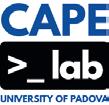
Massimiliano Barolo max.barolo@unipd.it Phone: +39 049 827 5473
Fabrizio Bezzo
fabrizio.bezzo@unipd.it Phone: +39 049 827 5468
Pierantonio Facco pierantonio.facco@unipd.it Phone: +39 049 827 5470
Francesco Sartori francesco.sartori.5@phd.unipd.it
https://research.dii.unipd.it/capelab
Investigation carried out in collaboration with ing. Federico Zuecco (BASF Italia SpA, Pontecchio Marconi; IT)

Figure 1. (a) Sketch of the process understanding methodology adopted; (b) consequent reduction in the batch length duration.
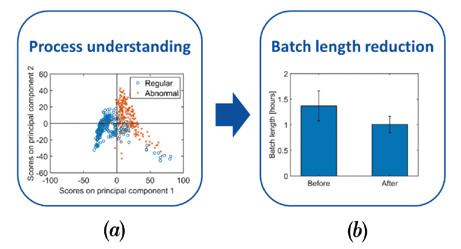
Main research topics:
• Data analytics; machine learning



• Product design and quality control
• Process modeling
• Design and optimization of energy systems
5 DIINFORMA
Bioingegneria, biotecnologie e tecnologie per la salute Bioengineering, biotechnology and health technologies
DII research group
Geometric Modeling and Prototyping Lab
Prof. Francesca Uccheddu francesca.uccheddu@unipd.it Phone: +39 049 8276796

Prof. Gianpaolo Savio Ing. Riccardo Sponchiado Ing. Luca Grigolato (also with DII) Ing. Pierandrea Dal Fabbro University of Padova - ICEA Dep
The research is part of the project "FD4AMFunctional Design for Additive Manufacturing" funded by the POR FSE 2014-2020 https://fgam.dicea.unipd.it/
The group focuses on applications in industrial and biomedical elds, where geometric complexity is an important element for the process management. Research activities are supported by a laboratory that is equipped with 3D scanners, 3D printers with binder jetting, stereolithography and fused deposition modeling technologies, coordinate measuring machines, pro lometer, roughness tester, mechanical testing machines, CAD / CAE, reverse engineering and additive manufacturing software.
Main research topics:
• Reverse Engineering
• Geometric models of free-form surfaces or mechanical components
• Design for Additive Manufacturing
• Innovative design methods
• Medical Device Design
A design method for custom functionally graded lattice orthoses

Orthoses and prostheses are devices that assist a disability or skeletal dysfunctions while locally improving the structural and functional characteristics of the musculoskeletal system. e most common uses for orthoses are body protection, movement assistance and prevention or correction of deformations thus making them useful objects for anyone suffering from osteoarthritis, fractures, tendon inflammation and neurological disorders just to mention a few. Additive manufacturing (AM) allows to create customized objects and products on demand for the individual user. Functionally Graded Additive Manufacturing (FGAM) is a function centered fabrication process that focuses on the performance modelling. Functionally Graded Materials (FGMs) are used to strategically control the density or the material composition inside the domain of a monolithic object.
When a patient suffers from arthritis or tendinitis certain movements can be more critical than others, even around the same pivot point. It can be therefore useful to exploit the functional grading of the orthosis to compensate these differential motion situations, for example by maximizing the stiffness of the orthosis where the movement should be prevented and minimizing it where it can be let free.
One way to control the stiffness of a FGM is by changing the local density of a lattice structure. is work presents a novel approach to semi-automatically design of an orthosis able to limit the motion and preventing the pain in patients with neuromuscular diseases. An example of wrist support was also fabricated, and the experience of the user was surveyed after six months of occasional use.
6 DIINFORMA
in doi:10.1007/978-3-031-15928-2_23
More information
Figure 2: two examples of orthoses modelled with the algorithm
Figure 1: Hand wrist orthosis wore by the subject.
H-HOPE: Hidden Hydro Oscillating Power for Europe
Recovering energy from water streams using low-cost devices is an unexploited but strategic research field. For these reasons, the H-HOPE – Hidden Hydro Oscillating Power for Europe project has been founded with almost 5 million euro by the EU's key funding programme for research and innovation “Horizon Europe”. Coordinated by Professor Giovanna Cavazzini, of the Department of Industrial Engineering of the University of Padua, in collaboration with the Giorgio Levi Cases Interdepartmental Center, the H-HOPE project intends to develop an innovative low-cost technological solution to recover the residual energy of water in currently unexploited water contexts, such as water distribution and purification networks, drainage channels and submarine and lagoon currents.
To allow the widest possible exploitation of the technology by both private and public users, preliminary design and development support tools will be available through the "Do-It-Yourself" platforms.
en, being the innovative cost-efficient system adaptable to the characteristics of applications ranging from pressure pipelines to open channels, several configurations (see, e.g., Figure 1) will be studied from the numerical (see, e.g., Figure 2) as well as the experimental point of view.
us, the technology will allow the digitization of artificial and natural networks and channels, increasing their resilience and sustainability.
Fourteen partners, including universities, research centers, and public utilities, coming from 9 different countries, will take part in the project, combining research activity in the hydroelectric sector with the needs of the public service in water management: the University of Padua, University Polytechnic of Catalonia (Spain), University of Uppsala (Sweden), University of Vienna (Austria), University of Ljubljana (Slovenia), University of Brno (Czech Republic), University of Reykjavik (Iceland), Tubitak research center (Turkey), Edison spa (Italy), Vattenfall AB (Sweden), OR Reykjavík Energy (Iceland), Acque Veronesi, Izmir Water and Sewage Administration (Turkey), CJH Multisourcing snv.
Energy Energia
DII research group
CAPE-Lab Computer-Aided Process Engineering Laboratory
Giovanna Cavazzini
Giovanna.cavazzini@unipd.it Phone: +39 0498276800
Alberto Benato
alberto.benato@unipd.it Phone: +39 049 8276752
Francesco De Vanna Francesco.devanna@unipd.it
https://research.dii.unipd.it/tes
H-HOPE Hidden Hydro Oscillating Power for Europe

Hidden Hydro Oscillating Power for Europe (H-HOPE) project has received funding from the European Union’s Horizon Europe research and innovation programme under the grant agreement n. 101084362
Main research topics:
• Energy Recovery from Water Streams

• Water Networks Digitalization
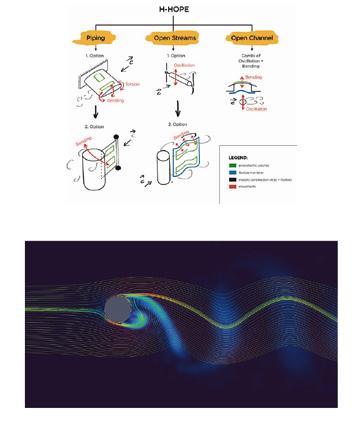


• Renewable Energy Sources
• Multi-physics Systems
• Life Cycle Assessment
• Waste Heat Recovery
• Energy Storage Systems
• Power Plants Optimization
DIINFORMA
7
Figure 1: Energy harvester configurations to be addressed during the H-HOPE project
Figure 2: Instantaneous vorticity field over a simple cylindrical energy harvesting configuration
Enrico Bernardo enrico.bernardo@unipd.it phone: +39 049 8275510
Inorganic Polymers from an Engineered Mixture of Waste: from Binders to Sorbents for Dye Removal
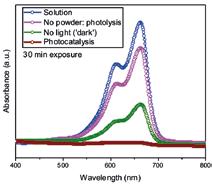
+39 049 8275828
https://research.dii.unipd.it/ceramglass

Research supported by “SusPIRe” project (Sustainable porous ceramics from inorganic residues, BIRD202134)
Cooperation from University of Trencin (Slovakia) in the framework of project “FunGlass” (Centre for Functional and Surface Functionalized Glass), funded by the European Union´s Horizon 2020 research and innovation programme under grant agreement No. 739566. https://www.funglass.eu/

e melting of red mud from bauxite refinement (18%), combined with coal combustion fly ash (58%) and discarded pharmaceutical glass (13%), with minor mineral addition, yields an alkali alumino-silicate precursor (45 wt% SiO₂, 19.5% Al₂O₃, 15.3% Fe₂O₃, 8.5% Na₂O) for a new generation of inorganic polymers. e high iron oxide promotes the separation of magnetite (Fe₃O₄ ) crystals, upon cooling. e material, once finely powdered (<75 µm) and suspended in alkaline solution (6-8 M NaOH, 65-70% solid content), undergoes partial dissolution of the glass matrix. e subsequent gelation, during drying at 70 °C, yields a semi-crystalline zeolite-like gel, binding unreacted particles. A ‘strong’ activation (8 M NaOH) leads to cementitious products (Fig.1) exhibiting a strength-to-density ratio comparable to that of conventional lightweight concrete. A ‘light’ activation (6 M NaOH) allows for the direct foaming of suspensions, at the early stages of gelation, by gas release offered by selected additives (e.g. Na perborate mono-hydrate, 1wt% on solid content), with the obtainment of highly porous bodies (porosity>80 vol%, see Fig.2), still exhibiting a good strength-to-density ratio. Interestingly, the latter products are reusable: powders from crushed foams may be used as advanced sorbents for dye removal, in which magnetite contributes to photocatalytic destruction.
Main research topics:
• Nanostructured ceramic composites from preceramic polymers and llers
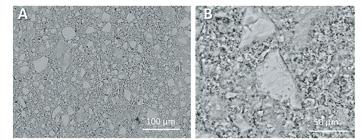
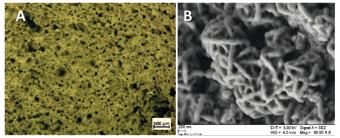
• Advanced porous ceramic components
• Bioceramics from novel formulations and processes

• Monolithic and cellular glasses and ceramics
• Novel building materials from inorganic waste


• Additive manufacturing of porous and dense ceramic components
Figure 3. Absorbance of methylene blue solutions: as prepared (10mg/mL); after UV light irradation ( λ=366 nm); after dispersion of powders from crushed foam and separation; after mixing with powders, UV irradiation and separation [powders extracted with a magnet]
8 DIINFORMA
DII research group CerAMGlass Materiali Materials
Hamada Elsayed hamada.elsayed@unipd.it phone:
Investigation performed with the support of Dr Akansha Mehta (visiting post-doc) of the FunGlass centre (Alexander Dubcek University of Trencin, Slovakia)
Figure 1. 8M activation: overall view (A), larger magnification detail of individual CMG particles surrounded by porous gel matrix (B)
Figure 2. 6M activation: foam from addition of Na perborate to the starting slurry (A), larger magnification detail of cell wall, highlighting the formation of zeolite crystals (B - courtesy of Dr. Elena Colusso)
Life cycle sustainability assessment to support ecoinnovation in HO-FOOD project
e increasing demand for a healthy diet calls for an evolution of the food processing chain, with special attention to fresh and organic products. In the last decades low temperature and food preservation techniques were developed to increase safety without affecting sensorial properties. anks to the European project HO-FOOD (Innovative High-pressure process to increase the preservation of ready-to-eat Organic FOOD) financed within the Susfood 2 Core Organic Consortium, intend to foster the whole fresh vegetable food chain via the development of a new food pasteurization technique, based on the use of high pressure CO. Prof. Sara Spilimbergo is the coordinator of the project and her research team “Superunit” is designing, fabricating, optimizing and testing small and medium scale plants (fig.1) which will be used to increase the preservation overtime of 3 organic food products: melon, pumpkin and almonds. Microbial, chemical and physical characterization, including sensorial and bio-accessibility analysis, will be performed by the other partners. To demonstrate the sustainability of the new process, Life Cycle Assessment (LCA) and Life Cycle Costing (LCC) are applied by SAM.lab group, coordinated by Prof. Anna Mazzi, to quantify environmental and economic performances of technology considering different end users, with “cradle-to-grave” approach (fig.2).
Fig.1: Schematic representation of the CO processi Fig.2: LCA-LCC framework
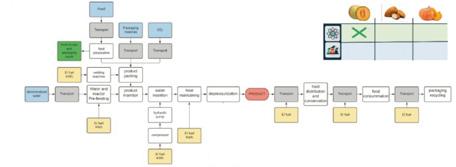
Sicurezza ambientale e industriale
Environmental and industrial safety
DII research group
SAM.lab Superunit
Anna Mazzi
anna.mazzi@unipd.it Phone: +39 0498271611

Elena Battiston
elena.battiston@phd.unipd.it Phone: +39 0498271611
Sara Spilimbergo sara.spilimbergo@unipd.it Phone: +39 0498275666
Alessandro Zambon alessandro.zambon@unipd.it Phone: +39 0498271612
Riccardo Zulli riccardo.zulli@phd.unipd.it Phone: +39 0498275550

Pietro Andrigo pietro.andrigo@phd.unipd.it Phone: +39 0498275550
A preliminary LCA study conducted from July to October 2022 (Fig 3) is focused on the pasteurization fresh cut melon at small scale (pasteurization chamber 4L). Coherently with the ISO 14040-44 standards, the goal and scope of LCA have been defined, including all processes “from farm to fork” , to quantify environmental impacts associated to the lab scale plant in terms of global warming, ozone depletion, ecotoxicity, acidification, eutrophication. e main assumptions in preliminary LCA study of melon are summarized in table 1.


Fig.3: System boundaries of preliminary LCA for melon treated in lab scale plant
Table 1: Main assumptions to model LCA of melon
Fabio Santi fabio.sant@phd.unipd.it Phone: +39 0498275550
www.dii.unipd.it
Partners involved in HO-FOOD project:
• University of Padova (UNIPD) Department of Industrial Engineering
• Institute of Agricultural and Food Biotechnology (IBPRS), Poland
• Council for Agricultural Research and Economics Research Center for Olive Citrus and Tree Fruit (CREA), Italy
• Université Ahmed Benbella Oran 1 (UNIO1) Department of Biology, Algeria



• Ataturk Central Horticultural Research Institute (TAGEM) Food Technologies, Turkey
For further information: https://susfood-db-era.net/main/HO-FOOD
Main research topics:
• Main research topics
• Sustainability assessment and management
• Eco-innovation and circular economy


• Innovative and mild food processing
• Food preservation and healthy products
9 DIINFORMA
Sistemi aerospaziali
Aerospace systems
Flight dynamics and space systems - FLIGHTDS
Francesco Branz francesco.branz@unipd.it
Phone: +39 049 8276779
ERMES: Experimental Rendezvous in Microgravity Environment Study
Alessandro Francesconi alessandro.francesconi@unipd.it Phone: +39 049 8276811
Assisted by:
Alessandro Bortotto
Giuliano Degli Agli
Mattia Dignani
Federico Favotto
Fabio Mattiazzi
Miroljub Mihailovic Nicola Pozzato https://www.dii.unipd.it/en/ ightds
ERMES is a student project of the Department of Industrial Engineering, University of Padova, carried out by master degree students. e team took part in the Fly your esis! 2022 programme organized and sponsored by the European Space Agency. ERMES deals with the design and development of a test for an autonomous docking manoeuvre between CubeSats mock-ups. Experiments are designed to be performed in the reduced-gravity environment obtained on the parabolic flights provided by Novespace on board a modified Airbus A310. e team conducted the flight campaign between 16th and 28th October 2022 in Bordeaux, France. e two mock-ups involved in the experiment are both equipped with a Guidance Navigation and Control (GNC) system and miniaturized docking interfaces. During the manoeuvre, they work in a target-chaser configuration, where the chaser is active and the target is cooperative. In the framework of the so-called New Space Economy, the project is motivated by the increased interested on small satellites applications and, particularly, on proximity operation systems for autonomous miniature platforms, due to their effectiveness for several applications, from on-orbit servicing to the assembly of large in-space structures.
ERMES team members: Alessandro Bortotto, Giuliano Degli Agli, Mattia Dignani, Federico Favotto, Fabio Mattiazzi, Miroljub Mihailovic, Nicola Pozzato
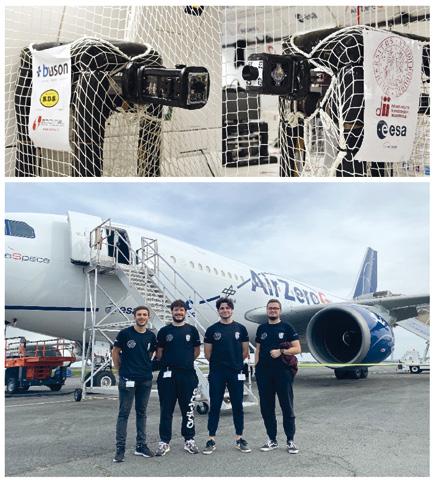
Support personnel: Lorenzo Olivieri, Alex Caon, Federico Basana, Luca Lion, Mattia Peruffo
Endorsing professors: Francesco Branz, Alessandro Francesconi


DIINFORMA Main research topics: • Space debris: risk analysis, protection systems from hypervelocity impact, risk mitigation • Active Debris Removal • Miniaturized satellites: on-board technologies and payloads • Systems for rendezvous and docking of satellites
10
Novespace
srl Buson srl Meccanica
European Space Agency - Education Office
(CNES) SOCIMA
sds
DII research group
Il progetto D3VeRo (La stampa 3D nel settore del VEtro artistico per Rilanciare ed innovare la filiera produttiva) intende rilanciare e ra fforzare la capacità competitiva della filiera del vetro, con particolare attenzione alle caratteristiche che contraddistinguono i processi di produzione e l’Arte dei Vetrai di Murano, uno dei più importanti ambiti produttivi regionali, che da secoli dà lustro e prestigio al Veneto ed all’Italia intera. Il progetto coinvolge diverse tecnologie abilitanti nell’ambito delle specializzazioni intelligenti “Smart Manufacturing” e “Creative Industries”. Il progetto ha una portata/visione globale che include sia l'avanzamento industriale per gli stampi e la produzione di vetro, sia industria 4.0 e IoT per l'azienda e verifica sperimentale con la collaborazione con i creativi. In particolare, si sono progettati e prodotti con stampa 3D degli stampi per vetro soffiato, in collaborazione con l’azienda Desamanera (www.desamanera.com).



Nella prima fase del progetto è stata portata avanti una attività di ricerca sui materiali volta a: 1) identificare i materiali e le formulazioni più promettenti per la realizzazione del supporto e del rivestimento per il contatto con il vetro; 2) identificare ed iniziare a testare le diverse variabili che possono influenzare la preparazione e l'utilizzo del pezzo; 3) programmare le visite alle vetrerie partners per conoscere il loro processo produttivo ed iniziare a testare in situ i prototipi sviluppati.


Nella seconda fase del progetto, le formulazioni sono state inizialmente sviluppate e stampate, contenenti materiale inerte a base di polvere di minerali naturali e leganti fosfato magnesiaci o geopolimerici, per poi svilupparne di migliorate per applicazioni ad alta temperatura (contatto con il vetro). Ci si è concentrati, quindi, nello studio del materiale per il rivestimento a contatto con il vetro. Lo studio si è concentrato sui leganti geopolimerici, vista la conoscenza del materiale e la disponibilità di materie prime legate l'utilizzo nella stampa 3D, a cui sono stati aggiunti filler (e.g. grafite) che possono aiutare e favorire il contatto/distacco con il vetro fuso. Particolare attenzione è stata riservata al processo di applicazione e consolidamento dei rivestimenti in relazione alle dimensioni e alla complessità dei pezzi registrati come prodotti. Infine, sono state programmate ed effettuate visite nelle vetrerie partners di progetto per studiare il loro processo produttivo e testare in opera i prototipi prodotti in Desamanera con le formulazioni sviluppate in laboratorio del DII.

DIINFORMA
stampa
settore del Vetro artistico
https://www.dii.unipd.it/ https://research.dii.unipd.it/ceramglass L'attività di ricerca del progetto è stata svolta in collaborazione con: • Universita' Ca' Foscari Venezia • Barovier e Toso Srl (VE) • Foscarini Spa (VE) • Desamanera Srl (RO) • Lavai Srl (TV) • DataVeneta Computers Srl (TV) • Accademia Di Belle Arti Di Verona • Universita' Di Verona • Euteknos 11 Filippo Gobbin lippo.gobbin@unipd.it Phone: +39 049 8275824 Giorgia Franchin giorgia.franchin@unipd.it Phone: +39 049 827 5508 Giulia Paciotti giulia.paciotti@unipd.it DII research group Advanced Ceramics and Glasses CERAMGLASS Speciale Paolo Colombo paolo.colombo@unipd.it Phone: +39 049 8275825 Hamada Elsayed hamada.elsayed@unipd.it
La
3D nel
per Rilanciare ed innovare la liera produttiva “D3VeRo
phone: +39 049 8275828
Cover story
Struttura reticolare avanzata a ‘giroide’. Questa struttura è formata da super ci lisce e continue, in nitamente estese nel volume, che dividono lo spazio in due regioni congruenti intrecciate. L’esempio in gura deriva da stampa stereolitogra ca (MSLA) di resina acrilica commerciale trasparente. La struttura esempli ca il modello per la manifattura additiva di bioceramici porosi ad alto rapporto resistenza-densità, risultanti dalla trasformazione termica del prodotto stampato, a sua volta ottenuto per llerizzazione della resina fotosensibile con polveri ceramiche e/o per miscelazione con polimeri preceramici.
Luca Grigolato
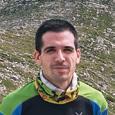
Laureato in Ingegneria Meccanica presso l'Università di Ferrara e successivamente in Ingegneria dell'Innovazione del Prodotto presso l'Università di Padova, è stato Assegnista di Ricerca presso il Dipartimento ICEA dell'Università di Padova interessandosi di metodi di progettazione, modellazione geometrica avanzata e multi-material Additive Manufacturing. Attualmente è Dottorando in Industrial Engineering e si occupa di metodi e strumenti computazionali per la modellazione geometrica basata su approcci volumetrici per l'Additive Manufacturing di componenti multi-funzionali ottimizzati. Lavora sotto la supervisione congiunta del Prof. Enrico Bernardo (DII) e del Prof. Gianpaolo Savio (ICEA).
DIPARTIMENTO DI INGEGNERIA INDUSTRIALE
SEDI
www.dii.unipd.it
Direttore: Stefania Bruschi
Vicedirettore: Piergiorgio Alotto
Segreteria amministrativa: Paolo Rando DII

Dipartimento di Ingegneria Industriale, Università degli Studi di Padova
Sede legale e amministrativa Via Gradenigo, 6/a - 35131 Padova
Via Marzolo, 9 - 35131 Padova
Via Venezia, 1 - 35131 Padova
